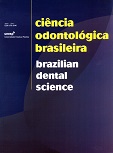Estudo da angulação da seringa carpule e das referências dentais utilizadas na técnica anestésica do nervo alveolar inferior
DOI:
https://doi.org/10.14295/bds.2004.v7i2.489Abstract
A técnica indireta de anestesia do nervo alveolar inferior é utilizada para anestesiar todos os dentes da mandíbula.É efetuada pela penetração de um centímetro da agulha anestésica em um ponto situado acima da oclusal dosdentes inferiores, medialmente à linha milo-hióidea, com o corpo da seringa acompanhando o alinhamento dosdentes inferiores, do mesmo lado a ser anestesiado. Em um segundo tempo, a seringa é levada para o lado opostoda boca e então se procede o restante da penetração da agulha, objetivando atingir as proximidades do sulcomandibular. Este estudo investigou qual região dentária do lado oposto ao lado a ser anestesiado deve ser usadacomo referência no segundo tempo da técnica, de forma a permitir o êxito da anestesia. Um cursor metálico foiadaptado em cada uma das cem mandíbulas secas estudadas, de modo a simular o trajeto da agulha anestésica noprimeiro tempo da técnica, determinar o ponto de inserção da agulha e a localização de sua ponta no momentoem que o cilindro da seringa era deslocado para o lado oposto ao lado anestesiado. Posteriormente as mandíbulasforam fotografadas, as imagens obtidas digitalizadas e realizados traçados simulando a posição do corpo daseringa anestésica no momento da penetração da agulha nas proximidades do sulco mandibular. Embora a regiãode pré-molares inferiores seja citada, pela maioria dos autores, como referência no segundo tempo da anestesia,este estudo evidenciou maior prevalência da região de primeiro molar.Downloads
Downloads
Published
How to Cite
Issue
Section
License
Brazilian Dental Science uses the Creative Commons (CC-BY 4.0) license, thus preserving the integrity of articles in an open access environment. The journal allows the author to retain publishing rights without restrictions.
=================




























